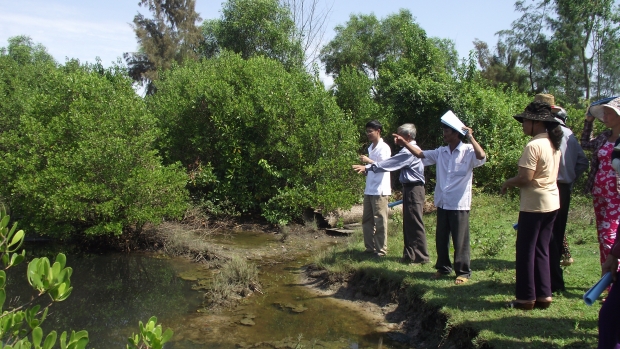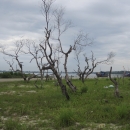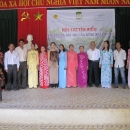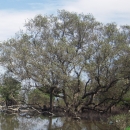Grants :: Small Grant Facilities :: Integrating sustainable livelihood improvement into mangrove restoration and conservation in An Hoa lagoon
Integrating sustainable livelihood improvement into mangrove restoration and conservation in An Hoa lagoon

Discussion on pilot sustainable aquaculture model linking wi ... , Nui Thanh District, Quang Nam Province, Vietnam © Tuan, H.H, 2012
Objectives
The project aimed to conserve mangroves linking with sustainable livelihoods improvement in An Hoa lagoon through building capacity for local community, facilitation of allocating mangroves to community and piloting crab culture models in mangrove protection areas.
Background
The area of mangroves in An Hoa lagoon is 65.82 ha. There are 18 mangrove species here, of which 11 are true mangrove species and 7 are mangrove associate species. Although the mangrove area is not large (only 3.5% of the lagoon area), it plays a crucial role in the protection of aquatic resources for the livelihoods of more than 6,500 households living in three communes around the lagoon. Local people exploit and harvest about 1,358 tons of aquatic resources (fish, shrimp, crab, clams, oysters) from this area annually.
According to local people, in the past the mangrove area around the lagoon was hundreds of hectares and mangrove species and aquatic resources were abundant. By 2011 however, the mangrove area was reduced and aquatic resources in the lagoon fell accordingly. Incomparison with 20 years ago, crab yields are reduced by 90% and shrimp yields have been reduced by 80%. This reduction was due to two main reasons:
- Local people's awareness about the role of mangroves in protecting the environment and aquatic resources was very low. Therefore, they destroyed mangrove areas for shrimp aquaculture, over exploited resources, and fished using destructive methods.
- The local authority (CPC) was not paying sufficient attention to mangrove protection and had not yet allocated mangrove areas to the community. The mangrove management mechanism was unclear and therefore mangrove areas continue to be destroyed.
The project was carried out in Tam Giang Commune where mangrove area remains large. In this area, local household incomes depended on fishery resources, thus mangroves were very important to their livelihoods.
Target beneficiaries
- 180 members of MCC and 10 households conduct pilot crab culture models as direct beneficiaries.
- More than 6,500 households living in three communes around the lagoon as indirect beneficiaries.
Outputs
1. Improved awareness of stakeholders (CPC and farmer) on mangrove roles.
2. Establishment of a pilot model of community based mangrove restoration and conservation linking with sustainable livelihood improvement.
3. Creation of a process for mangrove allocation by DPC to the community/village.
Accomplishments and challenges
Accomplishments:
- The project helped MCC members to recognize the value of mangroves and the linkage between mangrove conservation and sustainable aquaculture. Mangrove clearing for shrimp farming has stopped.
- Women were very active in project activities such as chairing the 6 MCC clubs and participating in trainings and mangrove knowledge competitions. Although there was no financial support from local authorities to run these clubs after the project ends, the commune Women's Union kept running the clubs by integrating conservation into the union's regular activities.
- Increase in awareness levels was not restricted only to MCC members but also for local authorities. Nui Thanh District People's Committee initiated the mobilization of other funding resources to replant mangroves inthe district. In November 2012, a large project to plant 60.94 ha of mangroves in Nui Thanh District, including 44.89 ha in Tam Giang Commune, was approved with a budget of around US$150,000. This reflected the positive impacts towards local government's commitment in development and protection of the mangrove area around An Hoa lagoon.
Challenges:
- The pilot mangrove-based crab culture models were not successful as all juvenile crabs died one month after being released. The causes are as follows:
-
The CPC delayed allowing 10 households to establish crab culture models in the mangrove areas because they wanted to check that these areas were not under dispute among households. This contributed to the failure of the crab culture because the crab seeds were dispersed in April when the water temperature was too high for survival.
-
The juvenile crabs were too small and there was a lack of technical support from HUAF due to distant project management. The grantee relied too much on the experience and knowledge of the local community. The project should have had more consultations with aquaculture experts before operating a crab culture model.
-
According to local households, the absence of a flood season during this year caused scarcity of natural juvenile crabs. Thus, they were ultimately bought from another province, reducing their average survival rate.
Contributions to cross-cutting themes
- Gender equality
- Communications
- Climate change
Lessons Learned
- Based on lessons drawn from the cab model's failure, it was necessary to conduct a detailed ex-ante situation analysis and receive consensus from all stakeholders (authorities, communities) before implementing the project.
- The grantee should have focused more on technical issues, taking seasonal factors into consideration and incorporate regular monitoring.
- Capacity of the grantees, such as the expertise required for project, should be carefully assessed before project implementation.
- The NCB should provide grants to locally-based organizations for better monitoring and management.
Featured Film - Lồng ghép cải thiện sinh kế với bảo tồn rừng ngập mặn tại đầm An Hòa, Quảng Nam
Lồng ghép cải thiện sinh kế với bảo tồn rừng ngập mặn tại đầm An Hòa, Quảng Nam, Quảng Nam, Việt Nam © Đại học Nông lâm Huế
Lể khởi động Dự án nhỏ về lồng ghép cải thiện sinh kế với bảo tồn rừng ngập mặn tại đầm An Hòa, Quảng Nam, Việt Nam
Project Facts
Country
Location
The An Hoa lagoon is about 1,900ha, located at the end of the Trương Giang river, Nui Thanh district, Quang Nam province
Topic
- Knowledge for Management
- Civil Society Engagement
- Capacity Building
- Sustainable Livelihoods
- Community Resilence
- Coastal Governance
- Climate change
- Gender equality
Duration
1st Oct 2011 to 30th Jun 2013
MFF Grant Amount
VND375,340,000
Implementing Partner
Mr.Hoang Huy Tuan, Vice-Dean
Forestry Faculty
Hue University of Agriculture and Forestry (HUAF)
No.102 Phung Hung, Hue City
Tel: 84-54-3522535. Fax: 84-54-3524923
HP: 0914263761
Email: hoanghuytuan69@yahoo.com
Website: http://huaf.edu.vn/



